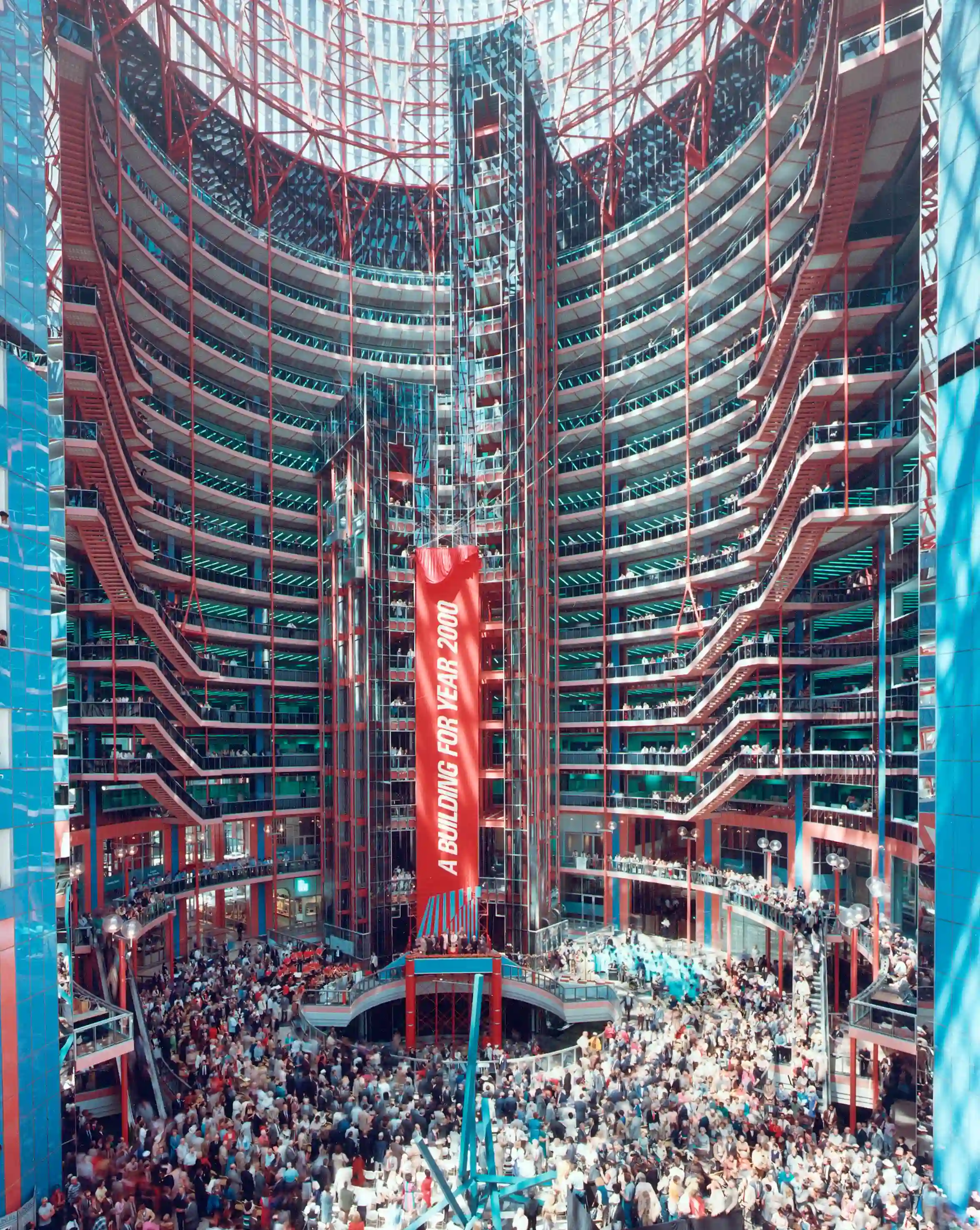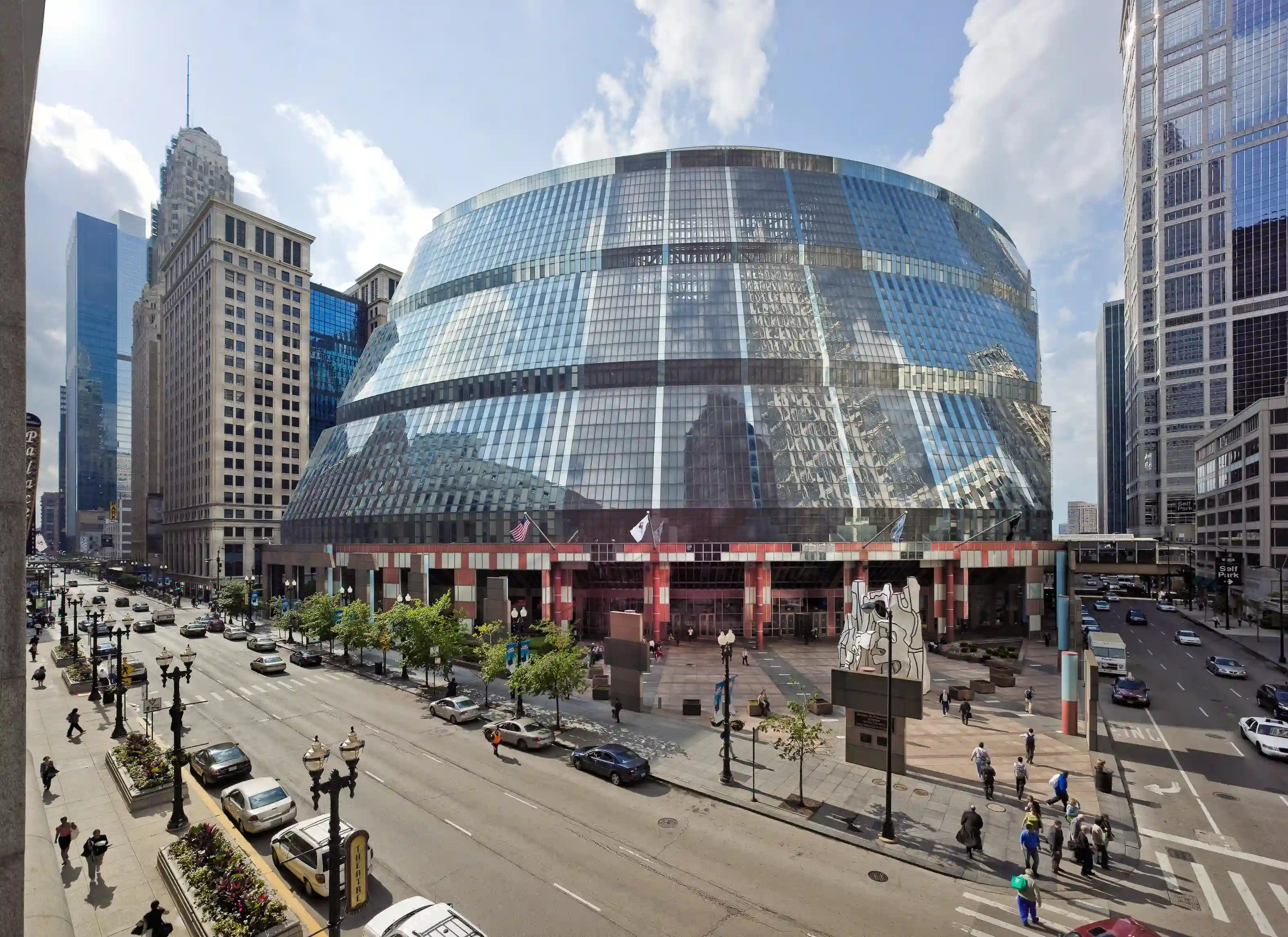After a years-long campaign, a nomination to list the James R. Thompson Center in Chicago to the National Register of Historic Places (NRHP) was rejected this month due to objection by the building’s current owner, Prime Realty. The news follows the announcement last July that Google parent company Alphabet would acquire the exuberant 1985 office complex that serves as one of Helmut Jahn’s most recognizable—and maligned—works for a second Chicago headquarters by 2026, following renovations overseen by Prime and the late architect’s firm, Jahn/.
The nomination, a 37-page document commissioned by the nonprofit Landmarks Illinois and written by architectural historian and writer Elizabeth Blasius and architect Jonathan Solomon of Preservation Futures with Chicago journalist AJ LaTrace, was just one part of a larger grassroots effort that sprung up around the future of the Thompson Center. The building’s fate has hung in the balance since its previous owner, the State of Illinois, first announced plans to put it up for sale in 2015. The diverse movement to save the so-called “Postmodern People’s Palace” from potential demolition has included sit-ins and rallies and garnered the support of prominent voices in the architecture community beyond Chicago. Jahn himself tirelessly defended the eccentric, glass-encased civic building often likened to a UFO that crash-landed in the heart of the Loop.

Opening day of the State of Illinois Center (May, 1985). Photo courtesy Jahn/
When it first opened at 100 W. Randolph Street as a satellite capitol complex known as the State of Illinois Center, the 17-story drum-shaped edifice drew both fanfare and derision for its unorthodox design and functionality. “It might be called architecture on amphetamines,” wrote Paul Goldberger in his initial review of the building for the New York Times, “Its squat form…is one part Pompidou Center, one part Piranesi, and one part kitsch 1950's revival.” Jahn, he concluded, could use “the architectural equivalent of a good editor.” Despite initial criticism, which extended to its bloated price-tag of $172 million, and complaints over the years from office workers about the confusing layout and unreliable heating and cooling, the Thompson Center’s soaring atrium and bustling basement-level food court saw the building thrive as a beloved public space.
By 2019, the Thompson Center had racked up an estimated $326 million in deferred maintenance and cost $17 million annually to operate—its uninsulated, glare-producing glass curtain wall made heating and cooling in the 1.2 million-square-foot building both inefficient and expensive. In the winter of 2021, less than a year after Jahn’s tragic death, Prime bought the property from the state for $70 million, announcing its intention to revamp it as a multi-use complex with Jahn’s namesake firm (now led by his son Evan Jahn) overseeing the design. Preliminary renderings released by Jahn/ at the time showed a significantly subdued Thompson Center, ridding the structure of its signature salmon-pink and blue color scheme.
Blasius, Solomon, and LaTrace began work on the nomination in 2019, before it was bought by Prime. “When a building is publicly owned, it's typically easier to list it on the National Register,” Blasius told RECORD. With the Thompson Center now in private hands, “the objection was something that we expected, she said.” A listing on the National Park Service-administered NRHP is a largely honorary distinction and does not regulate what alterations can be made to a listed site or even protect it from demolition. It can, however, as Preservation Futures noted in a recent press release announcing the nomination’s nixing, provide significant tax incentives to a building’s owner, including a 20 percent federal tax credit.
Blasius and her cohort were cautiously optimistic about Google’s announcement last summer: “The Thompson Center not being demolished in the state's hands is a win,” she said. “And the fact that Jahn/ is working on the renovation is very encouraging.” While Prime and Google have not explicitly acknowledged the nomination or any other preservation efforts, Karen Sauders, the tech giant’s president of Global Client and Agency Solutions and Chicago site lead, said at a July news conference that the intention is to “thoughtfully update the building to our high sustainability standards, while respecting its iconic design.” Google has previously adapted architecturally significant and historic buildings into offices. One of its New York offices is housed in the former Port Authority Building, a sprawling Art Deco landmark in Manhattan; the company is also nearing completion on its COOKFOX-led renovation of the nearby St. John's Terminal for another New York headquarters.

The Thompson Center takes up an entire city block in the Chicago Loop. Photo by Rainer Vertlboeck, courtesy Jahn/
Jahn/ executive vice president and managing director Philip Castillo, who joined the firm in 1980, declined to comment for this story, but told RECORD last summer that “these clients and users want to be respectful of the design.”
Google does have the option to renominate the Thompson Center once they take control of the property in 2026. However, while the company touted the acquisition as part of a full-throated investment in its “hybrid workforce” at the time, economic turbulence has plagued the tech industry in the months since, with Google laying off 6 percent of its global workforce in January. “That micro-collapse in the tech sector gives me pause,” said Blasius. The worst-case scenario, she says, is if Google and Prime continue to sit on the building while its condition deteriorates, until they sell it again or decide to demolish it outright.
Currently, the Thompson Center’s ground-level retail and the Chicago Transit Authority station remain open, but the atrium and interior were closed to the public last fall ahead of the planned renovations. “The public needs to know more about what's going to happen with the building,” says Blasius. No new renderings of the proposed revamp have been released since December 2021.
“We are not in a position to discuss any aspects of the final design at this time,” said Prime CEO Mike Reschke via email. “All I can say is that the project is very exciting and will be a very transformative building within the downtown Chicago market.”
“With the nomination being rejected, preservation advocacy groups will need to keep up the pressure,” added Blasius, who did not specify any actions planned by Preservation Futures. “Sometimes you save a building and then you've got to save it again.”







Post a comment to this article
Report Abusive Comment